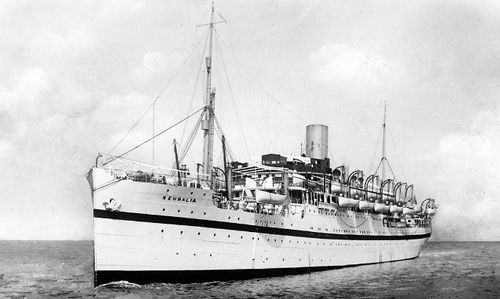Difference between revisions of "HMHS Neuralia"
From Our Contribution
| Line 1: | Line 1: | ||
| − | |||
| − | |||
| − | |||
| − | |||
| − | |||
| − | |||
| − | |||
| − | |||
| − | |||
| − | |||
| − | |||
| − | |||
| − | |||
| − | |||
| − | |||
| − | |||
| − | |||
| − | |||
| − | |||
| − | |||
| − | |||
| − | |||
| − | |||
| − | |||
| − | |||
| − | |||
| − | |||
| − | |||
| − | |||
| − | |||
| − | |||
| − | |||
| − | |||
| − | |||
| − | |||
| − | |||
{{Infobox ship | {{Infobox ship | ||
| image = [[File:HMHS_Neuralia_1.jpg|border|500px]] | | image = [[File:HMHS_Neuralia_1.jpg|border|500px]] | ||
Revision as of 19:05, 19 October 2021
 | |
| File:.jpg | |
| History | |
|---|---|
| Name | HMHS Neuralia |
| Owner | British India Steam Navigation Co. Ltd., London |
| Builder | Barclay Curle & Company, Glasgow |
| Yard number | 497 |
| Launched | 12 Sep 1912 |
| Completed | 2 Nov 1912 |
| In service | 1912 |
| Out of service | 1 May 1945 |
| Fate | struck a mine and sank |
| General characteristics | |
| Type | Passenger / Cargo vessel |
| Tonnage | 9,082 tons |
| Length | 480.5 ft |
| Beam | 58.1 ft |
| Depth | 30.8 ft |
| Speed | 14.5 knots (26.85 km/h) |
Contents
Remarks
Built for the British India Steam Navigation Company. Capacity: Passengers: 128 First Class, 98 Second Class. Launched 12th September 1912, completed 18th November 1912. The largest ship in the British India Fleet at this time. Sister ship to Nevasa, the pair were most imposing looking ships and were built for the London - Calcutta Service.
Requisitioned by the Admiralty on 12 Jun 1915 for use as a Military Hospital ship, and used during the Dardanelles Campaign in 1915, most notably at Suvla Bay and Salonika as a hospital ship. She then saw service in the Indian Ocean before returning to the UK in March of 1916 and remained on station with the Home Fleet until September 1918 when she was converted to an ambulance transport and remained as such until July 1919.
She carried a medical team of 11 Officers; 15 Nurses, Other personnel 60. She could accommodate 27 Officers, 245 in cots, and 358 in berths. On 31 Jul 1919 when she was returned to her owners.
In 1925 she was converted into a permanent Troopship and was managed by her owners as a hired transport (HMT). From 1932 until 1935 she undertook Summer school-ship cruises.
In April 1945 she took 1,700 Yugoslav refugees from the Canal Zone to Spoleto Yugoslavia and then left for Taranto, Italy to embark German POWs. At 2:00am on 1 May 1945 while turning into the Gulf of Taranto she struck a mine and the engine room flooded rapidly. Orders were given to abandon ship and her boats stood off. She was still afloat in the morning but as her boats approached to consider re-boarding she began to list and sank.